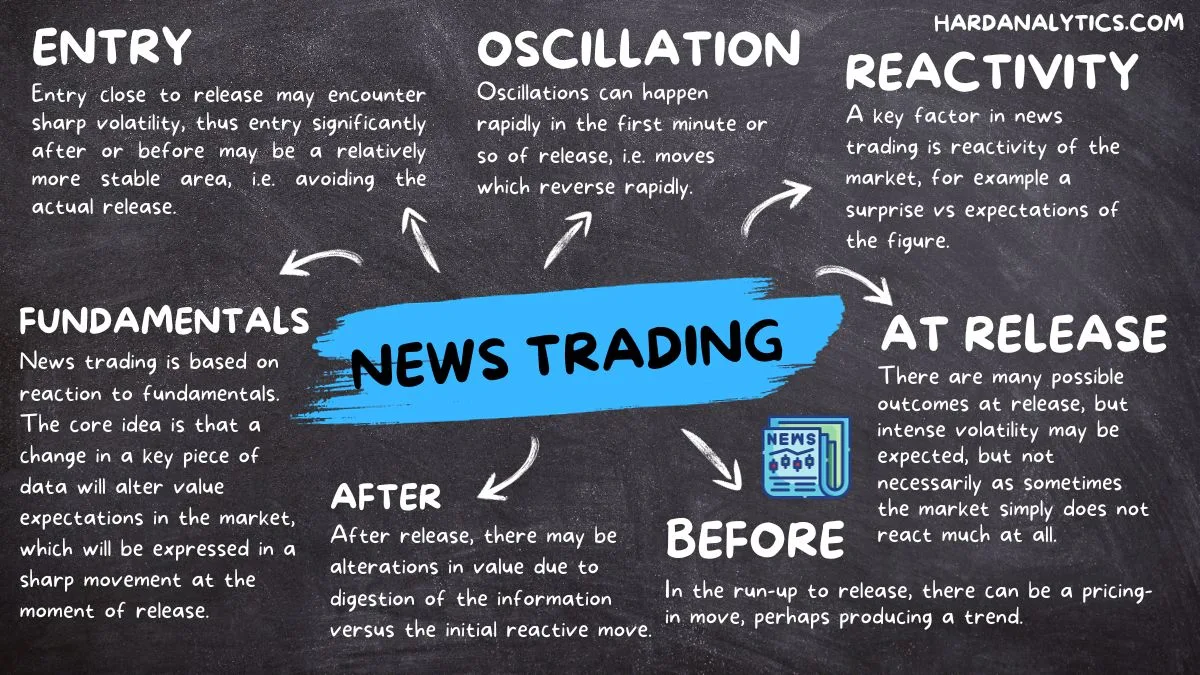Trading the news is a strategy used to try and capitalise on the effect of major data releases into the market. 'News' in this sense does not typically mean news as it is generally understood. This is because while news can affect a market, sometimes in a big way, it is by its nature usually unpredictable (this factor makes news compelling). So news in this sense means economic data or announcements, with this key feature, it is known when the release happens, but not the content of the release. Knowing when ties down the time factor, and appears to lessen the unpredictability. This in turn can create movement before, during and after the release, as the market speculates on its content, reacts to it and then digests it.
Because this type of data has been released over many cycles, another factor may be tied down, the type of reaction the market might expect. That is, changes in interest rates tend to have a certain kind of effect on the market, while the release of jobs can have another kind of effect. This creates a trading pattern. For example, interest rate changes may have a longer term implication, while jobs numbers could have a variability which makes each new iteration of the event, something of a blank slate. A longer term implication may result in the market not moving much, as this expectation is not a surprise event. Thus the capacity to speculate on the market reaction allied with the existence of past patterns, creates a trading market.
It can be seen that reactivity is a key factor in news trading. The expectation is that the market will react in some cases, but it may not as expressed in the actual outcome, or may not conform to the pattern expected, based on past expectations. News trading can be extremely tricky, as it tries to apply trading patterns to momentary volatile reactions. Volatility itself can be seen as a destoyer of regularity and patterns as well as the progenitor of more stable market forms. Before and after the news release the market may also express patterns geared towards the release, but this can be seen as a different type of trading market from the moment of release. It (before and after) is more like a regular trading market, however pulled or pushed from the events surrounding the release.
The element of surprise is a key factor in how the market may react. Generally in the run up to the announcement, the market will attempt to price in the expectation of the data. The more intense reactions may come when this pricing in has been proved incorrect, with the data release requiring another price level for the affected market. The least intense reactions may come when the pricing in has been proved correct, thus leaving the market at the level already priced in.

The trader may be tempted to trade directly into the news, in effect to see what the market does and try and ride it. This can be problematic for many reasons, not least of which it may be impossible to place the order through the provider. Or even it it goes through, spreads may be wide and it may not go through until the market has reached the level it desires, which can take a very short period of time indeed. This kind of trade may work in this situation, the trader gets in on the right side, avoiding the pitfalls of this type of trade, and then the market pauses and continues in the same direction. However many times the market will simply oscillate or stay around this level.
Another approach is to place a trade in the desired direction before the news release, but close to it. However such an apparently quiet market can be prone to sudden sharp moves, which may then reverse on the actual release (i.e. taking out stops).
Another approach is to trade the market, that is, to trade before release as expectations are priced in, exiting before the release or to trade after the release assuming anything is happening. Bottom line, the time of release can often as not be prone to oscillations happening in a very short period of time, which can make any approach, even using multiple positions, difficult to complete.
Major news releases have a consequence for trading outside of news trading, as they can push the market into a new level to range in, and the nature of the news underpins why this is happening, which is important when analysing a market in depth. News trading can provide an understanding of the nature of the market, the way it can move and respect support and resistance, even in intense volatility. And it can indicate a time not to trade as well.